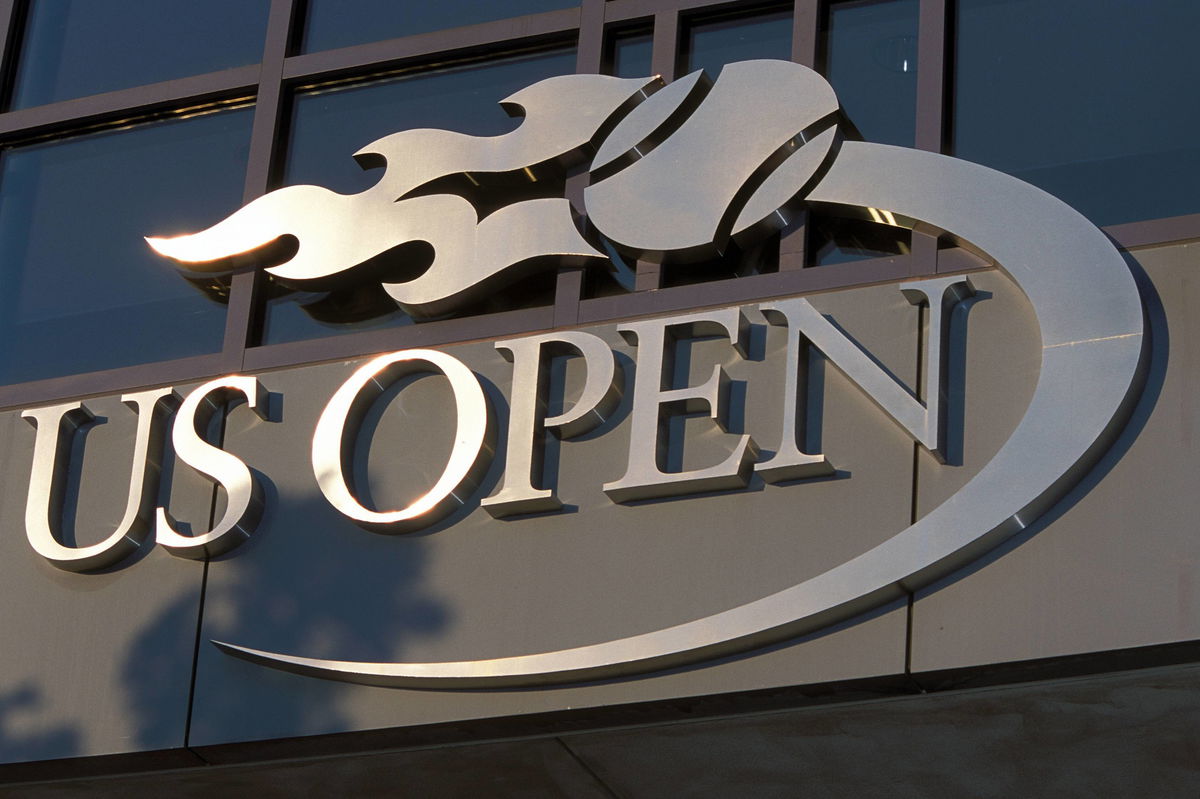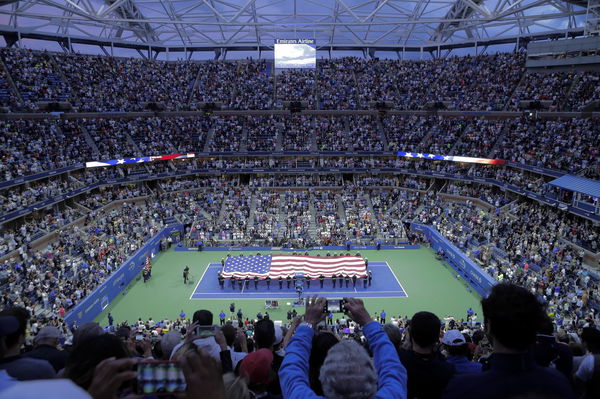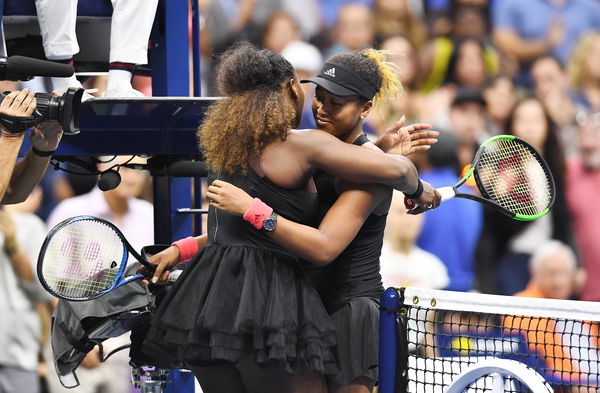
Imago
Bildnummer: 00628905 Datum: 26.08.2002 Copyright: imago/Claus Bergmann Das Emblem der US Open an einer Außenwand des Arthur-Ashe-Stadium; Vdia, quer, Freisteller, Embleme, Turnierlogo, Turnieremblem US Open 2002, Grand Slam, Logo New York Flushing Meadow Tennis Herren Einzel USA Einzelbild Randmotiv Objekte Logo

Imago
Bildnummer: 00628905 Datum: 26.08.2002 Copyright: imago/Claus Bergmann Das Emblem der US Open an einer Außenwand des Arthur-Ashe-Stadium; Vdia, quer, Freisteller, Embleme, Turnierlogo, Turnieremblem US Open 2002, Grand Slam, Logo New York Flushing Meadow Tennis Herren Einzel USA Einzelbild Randmotiv Objekte Logo
Tennis has always thrived on change, a sport defined by barrier-breakers who refuse to accept limits. Among the most powerful trailblazers stands Althea Gibson, who shattered the color barrier at the 1950 U.S. National Championships, now known as the US Open. Her courage reshaped history, and though she went on to claim five major titles in just eight years, her true legacy lies in opening the gates for generations of Black players who followed.
Watch What’s Trending Now!
Seventy-five years ago, when Gibson walked onto the courts of Forest Hills, N.Y., she did more than play a match; she transformed the sport. Her story of resilience and fearlessness now echoes through time, inspiring the 2025 event’s powerful theme, “Celebrating 75 Years of Breaking Barriers.”
This year’s theme comes alive through striking artwork by Melissa Koby, the first Black theme artist in the tournament’s history. Her creation, a layered silhouette of Gibson infused with US Open symbolism, captures both the magnitude of Gibson’s legacy and the promise of those yet to come.
ADVERTISEMENT
The celebration will reverberate throughout the three weeks of the 2025 tournament, running from August 18 to September 7. Every detail, from visuals to programming, will honor Gibson’s journey while spotlighting the future of barrier-breakers who carry her torch.
The centerpiece of the tribute arrives on Sunday, August 24, inside the iconic Arthur Ashe Stadium, as the Men’s and Women’s Singles Main Draws begin. On that day, the tournament will pause to honor Gibson, her courage, and the unshakable spirit that changed tennis forever.
ADVERTISEMENT
Althea Gibson: The Pioneer of today’s women victors at the US Open
Long before Venus and Serena Williams dominated the sport, before Sloane Stephens, Naomi Osaka, Coco Gauff, or Madison Keys raised Grand Slam trophies, Althea Gibson had already carved the path. On August 28, 1950, the South Carolina native shattered tennis’ greatest barrier when she stepped onto the courts of the West Side Tennis Club in Forest Hills for the US Nationals. In 1956, she became the first African American to win a Grand Slam title with her triumph at Roland Garros. Across her career, she amassed 11 Grand Slam crowns in singles, doubles, and mixed, earning her place among the game’s elite and a permanent ranking within the Top 10.
Her influence did not end with tennis. Gibson also made history as the first African American woman to join the LPGA Tour, carrying her trailblazing spirit from one sport to another. Her peers recognized her unmatched courage: Billie Jean King called her “our Jackie Robinson.” US Open champion Serena Williams, decades later in 2019, would reflect with awe, saying, “All the things she’s done for people like me, people that look like me, to be in the sport now, it’s just astonishing.”
ADVERTISEMENT

Imago
The United States flay is unfurled at center court in ceremonies before Roger Federer of Switzerland faced Novak Djokovic of Serbia in the Men s Final in Arthur Ashe Stadium at the US Open Tennis Championships at the USTA Billie Jean King National Tennis Center in New York City on September 13, 2015. PUBLICATIONxINxGERxSUIxAUTxHUNxONLY NYP20150913810 RAYxSTUBBLEBINE
The United States Flay is unfurled AT Center Court in Ceremonies Before Roger Federer of Switzerland faced Novak Djokovic of Serbia in The Men s Final in Arthur Ashe Stage AT The U.S. Open Tennis Championships AT The USTA Billie Jean King National Tennis Center in New York City ON September 13 2015 PUBLICATIONxINxGERxSUIxAUTxHUNxONLY
That kind of legacy deserves more than memory; it deserves celebration. Which is why the US Open has once again partnered with Marvel to honor Gibson’s story through a spectacular medium: comic books. For the second consecutive year, their collaboration has come alive, this time through a special edition spotlighting Gibson’s fight, triumph, and inspiration.
During the tournament’s Fan Week, held August 18-23 at the USTA Billie Jean King National Tennis Center in Flushing, N.Y., more than 40,000 copies of this original comic were handed out to fans free of charge, bringing Gibson’s story into the hands of a new generation.
ADVERTISEMENT
The narrative unfolds with the Fantastic Four discovering Gibson’s journey, her barriers broken, and her triumphs at Roland Garros, Wimbledon, and the US Open. Her victories, back-to-back at Wimbledon and the National Championships, cemented her as one of tennis’ most legendary champions.
Inspired by Gibson, the Fantastic Four carry her spirit into the heart of the US Open. On the courts of the USTA Billie Jean King National Tennis Center, they channel her resilience and strength, rising to face an “impossible” challenge, just as Gibson herself once did.
ADVERTISEMENT
Other barrier-breakers at the US Open
The tournament has long stood as more than just a tennis tournament, it has been a stage where the sport’s biggest voices demand change. Its history is steeped in groundbreaking milestones, often pushed forward by equally groundbreaking champions. Among them, Billie Jean King carved her place as a pioneer. In 1973, the US Open became the first Grand Slam to award equal prize money to men and women, a seismic move that shifted the landscape of the sport and set a precedent for equity that continues to resonate.
That fight for fairness began even earlier. In 1970, after winning Italy’s Foro Italico tournament, King discovered the glaring disparity between her $600 prize and the men’s champion’s $3500. Her fiery words ignited a movement: “Everyone thinks women should be thrilled when we get crumbs. And I want women to have the cake, the icing, and the cherry on top too.” Those words were not just a declaration; they were a battle cry that reshaped the sport forever.
The tournament’s pioneering spirit didn’t stop there. In 1997, when Arthur Ashe Stadium opened its doors, it was women who had the honor of inaugurating tennis’ grandest stage. Tamarine Tanasugarn and Chanda Rubin clashed in the first match, while Monica Seles lit up the first evening session under the Ashe lights. It was symbolic, another reminder that the US Open belonged equally to women as much as men.
But long before that, in 1968, Arthur Ashe blazed a trail of his own. Ashe became the first Black man to win the tournament, forever etching his name in history as a major champion of the Open Era. His legacy reached far beyond tennis, as he went on to capture titles at the Australian Open in 1970 and Wimbledon in 1975, all while standing tall as a civil rights activist and voice for justice.
As the decades passed, the US Open became a canvas for new waves of trailblazers. Venus and Serena Williams carried the torch, transforming the game with their dominance and redefining what was possible for Black women in sport. Serena, in particular, stood on the edge of immortality in 2002 and 2003, stringing together a reign of dominance rarely witnessed in tennis’ modern age.

Imago
Naomi Osaka of Japan is hugged by her opponent Serena Williams of the United States after winning the women s singles final match of the US Open tennis tournament at Arthur Ashe Stadium, USTA Billie Jean King National Tennis Center in Flushing, Queens, New York City, United States, September 8, 2018. Noxthirdxpartyxsales PUBLICATIONxINxGERxSUIxAUTxHUNxONLY (85372528)
That spirit of activism and advocacy carried forward into the next generation. Naomi Osaka made global headlines at the 2020 US Open, stepping onto the court wearing masks that bore the names of victims of racial injustice. Coco Gauff, equally fearless, lent her voice and platform to movements like Frances Tiafoe’s “Rackets Down, Hands Up” campaign, amplifying calls for social justice.
Together, they made clear that the tournament is more than a tournament. It is a movement, a stage where athletes do not just chase trophies but challenge the world to evolve. From King to Ashe, from Serena to Gauff, the US Open has become a symbol of courage, equality, and transformation, proof that the game’s true power lies not only in its champions but in the causes they carry forward.
Epic battles that shaped the US Open
The tournament is not just the final Slam of the season; it is the theatre where legends rise, rivalries burn, and new stars seize the spotlight. Set against the electric pulse of New York City, its nights under Arthur Ashe Stadium lights carry a magic no other tournament can match.
In the 21st century, this stage has delivered unforgettable tales etched into tennis history. Serena Williams’ first US Open crown in 1999, as a fearless 17-year-old, was only the prelude. Her reign through the 2000s and 2010s, six titles between 2002 and 2014, showcased power, athleticism, and a will that redefined women’s tennis. The tournament and Serena became inseparable, her story forever woven into its fabric.
Before Federer, Nadal, and Djokovic rewrote the sport, American fans clung to Andy Roddick. His 2003 triumph, blasted home with a serve and forehand of fire, became iconic, not just as his lone Grand Slam, but as the last American male Slam victory. For a nation raised on Sampras and Agassi, it was both a farewell and a beginning.
Drama reached new peaks with Federer and Djokovic. Their 2011 US Open semifinal remains immortal. Federer held two match points; Djokovic answered with one of the boldest forehands ever struck, a defiant winner that swung the match and the tournament. That moment signaled Djokovic’s arrival as the force who would no longer bow to Rafa or Roger.
Few finals stirred such emotion as 2018, when Naomi Osaka faced her idol Serena. At just 20, Osaka played fearless, winning in straight sets and becoming Japan’s first Grand Slam champion. The controversy surrounding Serena only heightened the intensity, but Osaka’s tears under the roar told the real story, this was history.
If Osaka marked a shift, Emma Raducanu rewrote destiny in 2021. A qualifier ranked outside the top 100, she stormed through without losing a set. At 18, she lifted the trophy, proving dreams could explode into reality on the sport’s grandest stage.
This is the United States Open Tennis Championships, where the impossible becomes inevitable, and the game transforms into legend.
The US Open as a catalyst for change
The United States Open Tennis Championships has always been a battleground for greatness, but now, technology shares the stage with the athletes. From line-calling precision to AI-driven insights, innovation has reshaped how the game is played, judged, and experienced.
Hawkeye stands as the ultimate game-changer. With high-speed cameras mapping every bounce, it delivers line calls with razor-sharp accuracy. Since debuting at the 2006 US Open, it has silenced disputes and fueled drama, as fans hold their breath for the replay verdict flashing on the big screen.
The system has evolved into Hawkeye Live, replacing line judges with 18 automated cameras and voice alerts. Accuracy within a millimeter ensures no shot goes unjudged, while pre-recorded calls keep the theater alive. It’s fairness, precision, and spectacle rolled into one.
IBM Watsonx brings the future courtside, offering real-time analysis, match predictions, and personalized feeds. Meanwhile, wearable tech arms players with data on stamina, movement, and recovery, an invisible weapon shaping performance off the court, even if in-game use remains restricted.
For fans, digital apps, VR, and interactive tools create an immersive world where distance disappears. The US Open proves tennis is not just tradition, it’s evolution, where every serve, every point, is sharpened by technology.
Looking ahead: the future of barrier-breaking
The 2025 US Open is stepping into the future with technology designed to thrill fans like never before. At the heart of this revolution is an AI-powered digital ecosystem, offering real-time answers through a chatbot, dynamic “Live Likelihood to Win” predictions, and match summaries sharpened by IBM’s powerful data platform. Every click on the redesigned app or website now brings richer insights, sharper highlights, and a truly personalized experience.
But the magic doesn’t stop at technology. The USTA is pushing global boundaries, strengthening its alliance with IMG to grow the game worldwide. With advanced digital platforms and deep data analytics, the Open isn’t just telling stories, it’s rewriting how the world connects with tennis.
Diversity also takes center stage. Rising stars from across the globe will light up New York, carrying forward a legacy built on athletic brilliance and unshakable narratives. The US Open isn’t just a tournament; it’s a celebration of inclusivity, unity, and possibility.
Now, the countdown is almost over. In just hours, under the lights of New York, this year’s version of magic begins to unfold. We are excited. Are you? Don’t forget to keep a tab on our live blog for the latest updates!
ADVERTISEMENT
ADVERTISEMENT
ADVERTISEMENT

